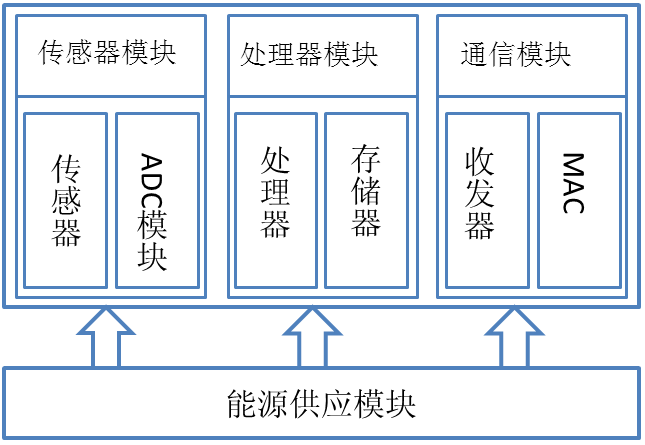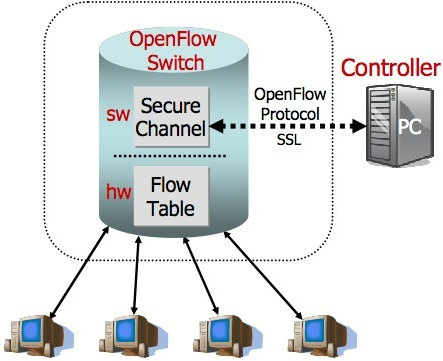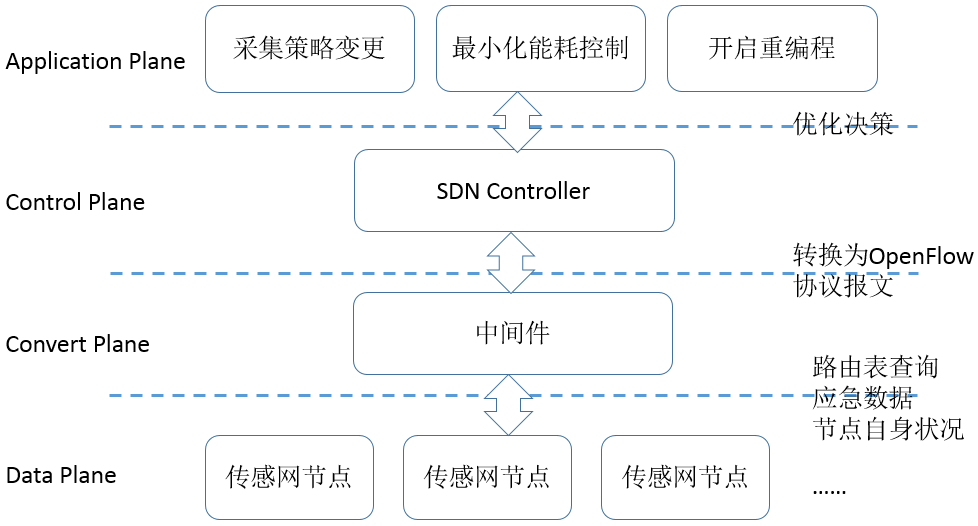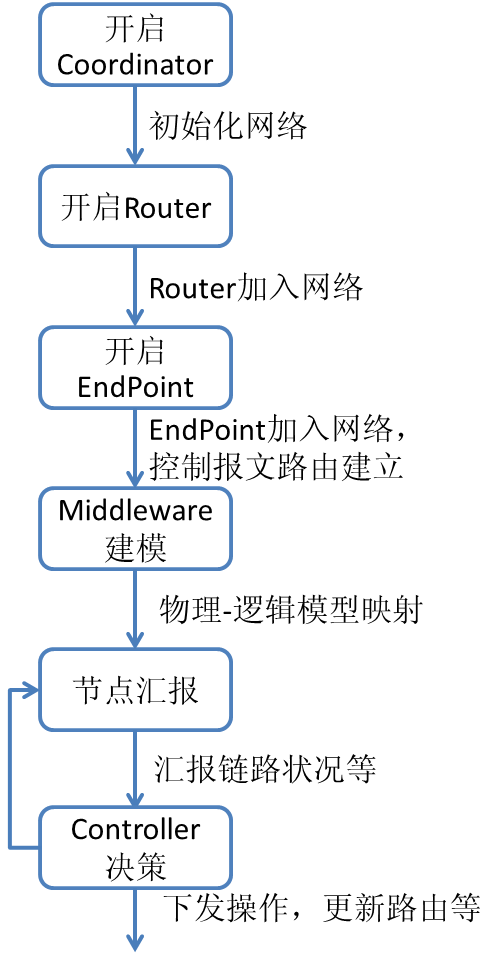论文总字数:40781字
摘 要
近年来,无线传感器网络(WSN)不仅在学术界受到持续关注,而且在环境监测、智能家居、健康医疗等领域得到了广泛应用。学术研究成果和实际部署经验表明能量有限的数据采集技术和灵活的网络拓扑管理技术仍然是无线传感网需要关注的核心问题和关键技术。而最近提出的软件定义网络(SDN)技术则具有集中式管理网络环境、控制平面与数据平面分离、具有完善的控制平面接口的优良特点,使得网络的管理与路由的决策变得简单便利。因此,本文提出在无线传感网中引入软件定义网络的技术和理念,构建软件定义的无线传感器网络(Software Defined Wireless Sensor Network, SD-WSN),提高WSN网络的效率和灵活性。本文内容主要包括以下几点:
首先分析软件定义无线传感网的相关技术研究现状:分析了无线传感器网络技术研究的核心问题和关键技术,总结当前无线传感器网络研究的技术难点;介绍基于OpenFlow的SDN技术特点;在此基础上分析在WSN网络中引入SDN技术的可行性,并对若干软件定义无线传感网的技术方案进行分析对比,指明相关工作存在的问题,并阐明本文工作的创新性。
然后介绍本文提出的SD-WSN的总体架构,包括:无线传感器多跳自组网、协议转换中间件、Mininet建模、SDN控制器及其应用等模块,并在此基础上进一步说明该系统的工作流程和工作目标,阐明了系统的工作原理。
接着阐述SD-WSN的原型系统的详细设计和实现细节,包括:基于树形路由协议实现WSN的自组网以支持SD-WSN的控制分组传输和应急数据传输;基于Mininet设计实现拓扑建模中间件和报文格式转换器;基于开源的POX软件实现网络控制器;设计了无线传感器网络拓扑信息测量和采集算法。SD-WSN具有符合OpenFlow规范、传感节点协议简单、负载小、易于实现等特点。
随后介绍了基于SD-WSN的若干应用系统的开发、实现和部署情况,包括:智能猫眼系统、智能抄表系统以及静脉输液监护系统。
最后是结论,系统实现和部署测试结果表明,SD-WSN在灵活管理网络拓扑、节点负载均衡、延长网络生命周期、动态调整数据采集行为等方面具有优势。
关键词:无线传感网,软件定义网络,网络管理,负载均衡,动态调整
Research on Software Defined Wireless Sensor Network Technologies
Abstract
In recent years, wireless sensor network (WSN) not only is concerned about persistently in academia, but also has been widely used in environmental monitoring, smart home, health care and other fields. Academic research and practical deployment experience has shown that the energy-constrained data acquisition technology and flexible network topology management are still the core issues and key technologies a WSN should focus on. Meanwhile, the recently proposed software defined network (SDN) technology with numerous excellent features, including the centralized management of the network environment, the separation of control plane and data plane, and the perfect control plane interface, makes network management and routing decisions become more simple and convenient. Therefore, in this paper, we put forward the concept of applying SDN technologies to WSN, constructing Software Defined Wireless Sensor Network (SD-WSN), increasing the efficiency and flexibility of WSN. This paper mainly includes the following:
Firstly, we analyze the research status of software defined wireless sensor network, including investigating the core issues and key technologies of WSN; summarizing the current technical difficulties in WSN; introducing the technical features of OpenFlow based SDN. After that, we discuss the practicability of applying SDN to WSN, compare a number of software defined wireless sensor network proposals, point out their problems and clarify the creative works in this paper.
Secondly, we introduce the overall architecture of proposed SD-WSN prototype system, including wireless sensor multi hop network, protocol conversion middleware, Mininet modeling, SDN controller and its application. On the basis we illustrate the system work flow, work target and work principle.
Then, we describe details in design and implementation of SD-WSN, including applying tree-based routing protocol MANNET to WSN to support the control packet and emergency data transmission in SD-WSN; developing topology modeling middleware with Mininet and designing packets format converter; achieving network controller with POX; designing WSN topology information measurement and collection algorithms. Naturally, SD-WSN is an OpenFlow based, easy to implement, platform with small load.
Furthermore, we develop and deploy three SD-WSN applications named "Smart Cat System", "Automatic Meter Reading System" and "Intravenous Infusion Monitoring System".
Finally, we experiment SD-WSN system's implement and deployment. The test results show that the system has the advantage in flexible management of network topology, nodes load balancing, network life cycle extension, dynamic adjustment of data collection and other aspects of behavior.
Keywords: wireless sensor networks, software-defined networks, network management, load balancing, dynamic adjustment
目录
软件定义无线传感器网络技术研究 I
摘要 I
Research on Software Defined Wireless Sensor Network Technologies II
Abstract II
目录 IV
图目录 VI
第一章 绪论 1
1.1 研究背景和意义 1
1.2 主要研究内容和目标 2
1.3 论文的主要贡献 4
1.4 论文的主要内容和安排 5
第二章 相关技术研究 6
2.1 无线传感网及其关键技术 6
2.2 基于OpenFlow的软件定义网络 7
2.3 基于SDN的WSNs 9
第三章 SD-WSN网络总体结构 11
3.1 系统架构 11
3.2 相关流程 12
3.2.1 网络启动流程 12
3.2.2 节点加入流程 13
3.2.3 报文传输流程 14
3.2.4 策略更新流程 14
3.3 本章小结 15
第四章 SD-WSN网络原型系统的设计和实现 16
4.1 WSN组网 16
4.2 中间件模块实现 19
4.3 控制器模块实现 24
4.4 工作流程 26
4.5 本章小结 27
第五章 实际应用实现与部署 28
5.1 应用设计 28
5.1.1 智能抄表系统 28
5.1.2 智能猫眼系统 30
5.1.3 静脉输液系统 31
5.2 应用实现 32
5.2.1 需求分析 32
5.2.2 开发平台 34
5.2.3 相关算法设计 38
5.3 实际部署与实验 38
5.3.1 传统WSN工作模式 39
5.3.2 SD-WSN工作模式 40
5.4 本章小结 40
第六章 总结和展望 41
6.1 课题总结 41
6.2 展望 41
参考文献 43
致谢 47
本科期间参与的科研工作和所获成果 48
竞赛 48
论文 48
专利 48
图目录
图1-1 软件定义的传感网拓扑模型 1
图2-1 无线传感网工作模型 6
图2-2 无线传感器节点模块组成 7
图2-3 基于OpenFlow的SDN架构 8
图3-1 SD-WSN网络部署图 11
图3-2 基于SDN的WSN系统逻辑框架 12
图3-3 网络启动流程 12
图3-4 节点加入流程 13
图3-5报文传输流程 14
图3-6 策略更新流程 15
图4-1 树型路由拓扑 16
图(组)4-2 TOS_Msg数据报结构体 18
图4-3 TinyOS各组件之间的调用关系 18
图4-4 数据传输流程 19
图4-5 OpenFlow FlowTable包头域结构 20
图4-6 流表匹配流程 20
图4-7 包头域解析流程 21
剩余内容已隐藏,请支付后下载全文,论文总字数:40781字
相关图片展示:





该课题毕业论文、开题报告、外文翻译、程序设计、图纸设计等资料可联系客服协助查找;


